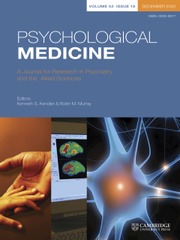Crossref Citations
This article has been cited by the following publications. This list is generated based on data provided by
Crossref.
Oathes, Desmond J.
Squillante, Christian M.
Ray, William J.
Nitschke, Jack B.
and
Hashimoto, Kenji
2010.
The Impact of Worry on Attention to Threat.
PLoS ONE,
Vol. 5,
Issue. 10,
p.
e13411.
Wilamowska, Zofia A.
Thompson-Hollands, Johanna
Fairholme, Christopher P.
Ellard, Kristen K.
Farchione, Todd J.
and
Barlow, David H.
2010.
Conceptual background, development, and preliminary data from the unified protocol for transdiagnostic treatment of emotional disorders.
Depression and Anxiety,
Vol. 27,
Issue. 10,
p.
882.
Osinsky, Roman
Alexander, Nina
Gebhardt, Helge
and
Hennig, Juergen
2010.
Trait anxiety and dynamic adjustments in conflict processing.
Cognitive, Affective, & Behavioral Neuroscience,
Vol. 10,
Issue. 3,
p.
372.
Verkuil, Bart
Brosschot, Jos F.
Gebhardt, Winifred A.
and
Thayer, Julian F.
2010.
When Worries Make you Sick: A Review of Perseverative Cognition, the Default Stress Response and Somatic Health.
Journal of Experimental Psychopathology,
Vol. 1,
Issue. 1,
Moul, Douglas E.
2010.
Science of Awakening.
Vol. 93,
Issue. ,
p.
193.
Etkin, Amit
Prater, Katherine E.
Hoeft, Fumiko
Menon, Vinod
and
Schatzberg, Alan F.
2010.
Failure of Anterior Cingulate Activation and Connectivity With the Amygdala During Implicit Regulation of Emotional Processing in Generalized Anxiety Disorder.
American Journal of Psychiatry,
Vol. 167,
Issue. 5,
p.
545.
Ruscio, Ayelet Meron
Seitchik, Allison E.
Gentes, Emily L.
Jones, Jason D.
and
Hallion, Lauren S.
2011.
Perseverative thought: A robust predictor of response to emotional challenge in generalized anxiety disorder and major depressive disorder.
Behaviour Research and Therapy,
Vol. 49,
Issue. 12,
p.
867.
Schienle, Anne
Hettema, John M.
Cáceda, Ricardo
and
Nemeroff, Charles B.
2011.
Neurobiology and Genetics of Generalized Anxiety Disorder.
Psychiatric Annals,
Vol. 41,
Issue. 2,
p.
113.
Luyten, Laura
Vansteenwegen, Debora
van Kuyck, Kris
Gabriëls, Loes
and
Nuttin, Bart
2011.
Contextual conditioning in rats as an animal model for generalized anxiety disorder.
Cognitive, Affective, & Behavioral Neuroscience,
Vol. 11,
Issue. 2,
p.
228.
Andreescu, Carmen
Gross, James J.
Lenze, Eric
Edelman, Kathryn Dunfee
Snyder, Sara
Tanase, Costin
and
Aizenstein, Howard
2011.
Altered cerebral blood flow patterns associated with pathologic worry in the elderly.
Depression and Anxiety,
Vol. 28,
Issue. 3,
p.
202.
Palm, M. E.
Elliott, R.
McKie, S.
Deakin, J. F. W.
and
Anderson, I. M.
2011.
Attenuated responses to emotional expressions in women with generalized anxiety disorder.
Psychological Medicine,
Vol. 41,
Issue. 5,
p.
1009.
Price, R B
Eldreth, D A
and
Mohlman, J
2011.
Deficient prefrontal attentional control in late-life generalized anxiety disorder: an fMRI investigation.
Translational Psychiatry,
Vol. 1,
Issue. 10,
p.
e46.
Hahn, Andreas
Stein, Patrycja
Windischberger, Christian
Weissenbacher, Andreas
Spindelegger, Christoph
Moser, Ewald
Kasper, Siegfried
and
Lanzenberger, Rupert
2011.
Reduced resting-state functional connectivity between amygdala and orbitofrontal cortex in social anxiety disorder.
NeuroImage,
Vol. 56,
Issue. 3,
p.
881.
Hettema, John M.
Kettenmann, Birgit
Ahluwalia, Vishwadeep
McCarthy, Christopher
Kates, Wendy R.
Schmitt, James E.
Silberg, Judy L.
Neale, Michael C.
Kendler, Kenneth S.
and
Fatouros, Panos
2012.
Pilot multimodal twin imaging study of generalized anxiety disorder.
Depression and Anxiety,
Vol. 29,
Issue. 3,
p.
202.
Brambilla, P.
Como, G.
Isola, M.
Taboga, F.
Zuliani, R.
Goljevscek, S.
Ragogna, M.
Brondani, G.
Baiano, M.
Perini, L.
Ferro, A.
Bazzocchi, M.
Zuiani, C.
and
Balestrieri, M.
2012.
White-matter abnormalities in the right posterior hemisphere in generalized anxiety disorder: a diffusion imaging study.
Psychological Medicine,
Vol. 42,
Issue. 2,
p.
427.
Vytal, Katherine
Cornwell, Brian
Arkin, Nicole
and
Grillon, Christian
2012.
Describing the interplay between anxiety and cognition: From impaired performance under low cognitive load to reduced anxiety under high load.
Psychophysiology,
Vol. 49,
Issue. 6,
p.
842.
Blair, Karina S.
and
Blair, R. J. R.
2012.
A Cognitive Neuroscience Approach to Generalized Anxiety Disorder and Social Phobia.
Emotion Review,
Vol. 4,
Issue. 2,
p.
133.
Koch, Kathrin
and
Mathiak, Klaus
2013.
Funktionelle MRT in Psychiatrie und Neurologie.
p.
691.
Flaten, Magne Arve
Aslaksen, Per M.
and
Lyby, Peter S.
2013.
Placebo and Pain.
p.
73.
Buoli, Massimiliano
Caldiroli, Alice
Caletti, Elisabetta
Paoli, Riccardo Augusto
and
Altamura, Alfredo Carlo
2013.
New approaches to the pharmacological management of generalized anxiety disorder.
Expert Opinion on Pharmacotherapy,
Vol. 14,
Issue. 2,
p.
175.

